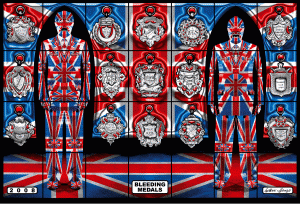« Reviews
Gilbert & George - Jack Freak Pictures
White Cube Gallery – London, UK
10 July – 22 August, 2009
By Claire Breukel
The large-scale Gilbert and George extravaganza “Jack Freak Projects” is spread in two parts across the White Cube’s Mason Yard and Hoxton Square galleries. Gilbert Prosech and George Passmore met in 1967 whilst studying at Saint Martins School of Art in London, fell in love, married and currently reside in Spitalfields, East London. For years to follow, this couple has created bodies of work based on London’s East End, using it both as a case study and metaphor for a larger dialogue. Their work became typified by an autobiographical stance—using their own physicality, their activities and the influences of this environment—as subject. Along with the large grid-like images pushed to the foreground, thick with code and innuendo, this approach created a language that has become synonymous with their work. As a continuation of this, Jack Freak Pictures is a series of larger-than-life images…however darkly (un)patriotic and more humorously flippant than ever before.
“Jack” in the exhibition title is a reference to the Union Jack British flag, a motif entering almost all the works in the exhibition. This is most evidently translated on comic Union Jack-matching suits worn by the artists, and on patterned backdrops, echoing the commercialization and universal consumption of this symbol. “Jack” alludes to an everyday non-specific name, a John Doe perhaps, and could even be an innuendo for “Jack shit,” one of the works titles…. “Freak” one would assume is the ambiguous emphasis of the unusual in these works. Many of the images feature distorted freakish representations, and at times the artists’ heads and bodies are distorted, even dismembered. Flattened kaleidoscopic picture planes give one the impression of being immersed in some kind of psychedelia, unnervingly pleasing to the eye whilst at the same time strangely disturbing. This feeling of oxymoron and push-and-pull is carried throughout the series giving us the impression that Gilbert and George—as subjects—are happily dysfunctional, celebrating what is inherently different or out of place.
In the works Frigidarium and Bleeding Medals, amongst others, Gilbert and George—the actors—appear surrounded by antique medals—as props. These iconic decorations acknowledge a variety of local sporting achievements, but there is a dark strangeness in this absurd patriotism. Placed in the images as graphic insignia next to the actors’ mummified forms, comical poses and muted faces, these medals, like the Union Jack flag, become objects of pattern. This absurd juxtaposition usurps the common meaning of these symbols and in so doing the artists expertly and playfully construct a feeling of discomfort. Are they mocking their original meaning? Or mocking the viewer for taking the meanings so seriously and at face value? Turning traditional association on its head, Gilbert and George appear to be having fun with subjects that would ordinarily demand prudence and virtuosity. Despite their openly conservative political views, as subjects and artists they are tolerant and accepting of alternative meaning. And as if at a voting booth, as viewers we are left to determine whether we are sympathetic or opposed, tolerant or intolerant.
Over 153 works have been created for the Jack Freak Picture series to be exhibited in seven European galleries. The grandiose, larger-than-life approach to their work makes for an immersive as well as invasive experience. The pictures themselves become a bizarre collage construction of codes, creating dramatic dioramas that appear oddly garish, with exaggerated forms and intensified primary and neon colors. The overall effect is one that seems to appreciate absurdity and loom over the viewer in a way that is both thrilling and to be honest… a little frightening.
Claire Breukel: Project Coordinator PUMAVision and Curator PUMA Creative
Filed Under: Reviews



































